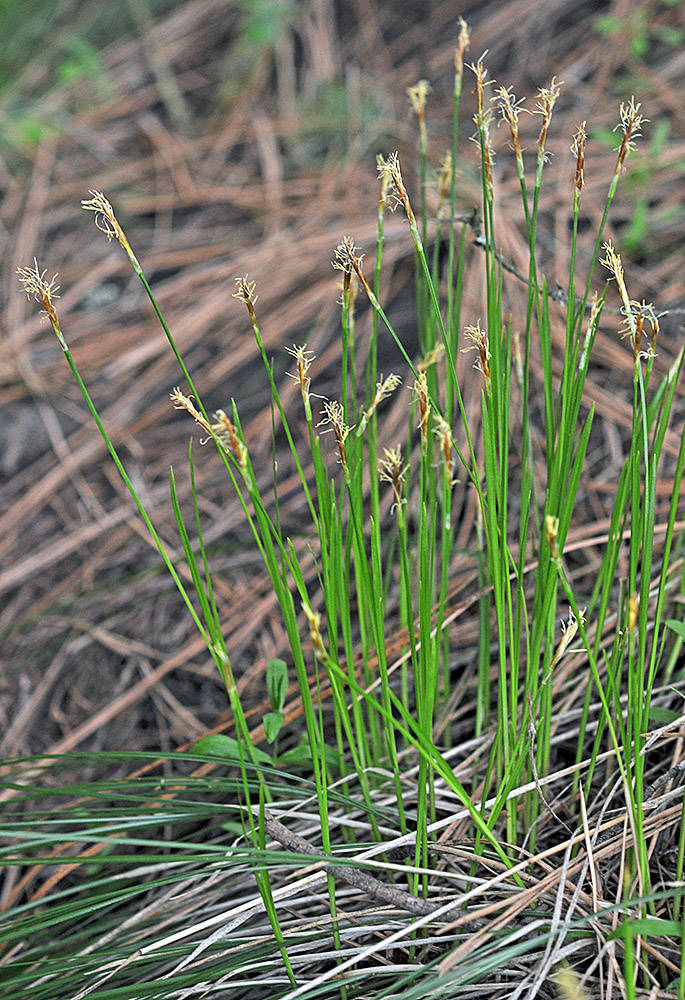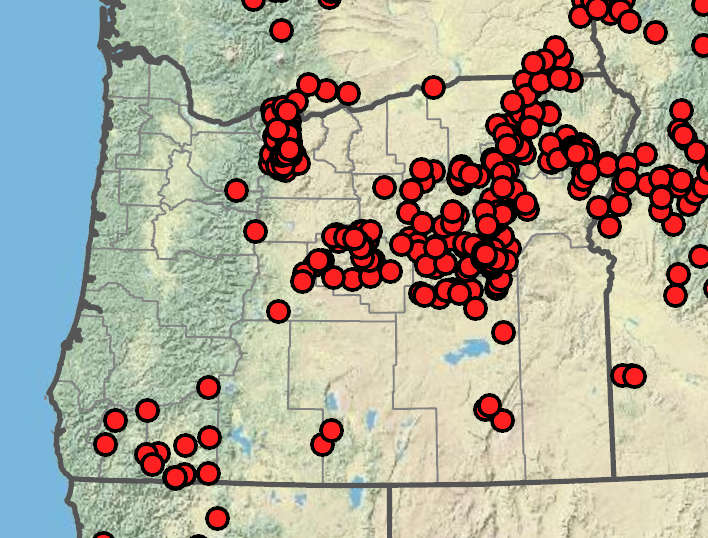|
elk sedge
|
many-rib sedge
|
| Plants loosely cespitose or short rhizomatous, with thick, dark, shallow rhizomes; culms 12–50 cm, triangular in cross section. |
Plants cespitose, 14–110 cm tall. |
1.1–3.5 mm wide; flat; evergreen; leathery; as long as or longer than the culms. |
(2)3–5 mm wide. |
spike solitary, androgynous, lacking inflorescence bracts; male terminal portion 1–2.5 cm long, separated from the 1–3 perigynia by a short internode. |
1.6–3 cm × 12–20 mm; dense and head-like; spikes gynaecandrous, occasionally female. |
obovate, rounded at the top, 5–7(8.5) × 1.8–2.8 mm, green; whitish, or brown; beak small; stigmas 3. |
smoothly oval to obovate; plano-convex; (3.8)4.4–5.8(6.5) × (1.4)1.8–2.8(3.3) mm, cream-colored or tan with green “shoulders,” becoming uniformly straw-colored with age; dorsal veins (8)10–17 and on dried specimens usually appearing sunken; ventral veins (0)4–12; wing (0.2)0.3–0.4(0.5) mm wide; broad near the beak but narrow lower on the body; beak winged nearly to the tip, 2–2.8(3.3) mm from achene top to beak tip; stigmas 2. |
trigonous. |
lenticular, 1.7–2.4 × 1.1–1.7 mm. |
the lower longer than the perigynia; the upper reduced; more or less brown with paler midrib and margins, pointed to awned. |
(3.2)3.9–4.8 mm; gold or light brown with paler midrib and margins; longer and narrower than the perigynia. |
|
|
|
|
|
|
|
Well-drained soils in dry, open, conifer forests, aspen stands, and openings, rarely in sagebrush, on both serpentine and nonserpentine substrates. 100–2500 m. BR, BW, Col, ECas, Lava, Owy, Sisk. CA, ID, NV, WA; north to southeastern British Columbia, east to CO, PA. Native. Carex geyeri is a common ground cover in open forest, especially in northeastern Oregon, recognized by its tough, flat, evergreen leaves from dark, scaly rhizomes. Similar pinegrass, Calamagrostis rubescens, usually has hairy internodes and when in flower it is easily distinguished. Carex geyeri is important food for wildlife and livestock, especially in winter. In southwestern Oregon, C. geyeri can be confused with C. multicaulis, which is densely cespitose and has proportionately shorter, usually involute leaves, and longer, green, leaf-like, lower female scales. |
Dry grasslands, mesic meadows and open forests. 600–2800 m. BR, BW, Casc, ECas, Sisk. CA, ID, NV, WA; northeast to MT. Native. Carex pachycarpa is a “ball-headed” bunchgrass sedge with large, pale, shaggy heads. Its pale perigynia have smooth oval bodies and wings that are broad near the beak but taper smoothly to become narrow beside the achene. Dorsal perigynium veins may appear impressed rather than raised. Individuals in the Warner Mountains may have unusually long, lanceolate perigynia. Other montane upland species (within subkey 9) with dense heads have darker or more compact inflorescences. This species can be confused with Californian C. multicostata. |
Flora of Oregon, volume 1, page 202
Barbara Wilson, Richard Brainerd, Nick Otting |
Flora of Oregon, volume 1, page 218
Barbara Wilson, Richard Brainerd, Nick Otting |
C. abrupta, C. agastachys, C. amplifolia, C. angustata, C. aperta, C. aquatilis, C. arcta, C. arenaria, C. atherodes, C. athrostachya, C. atrosquama, C. aurea, C. barbarae, C. bebbii, C. bolanderi, C. brainerdii, C. brevior, C. breweri, C. buchananii, C. buxbaumii, C. californica, C. canescens, C. capillaris, C. capitata, C. chordorrhiza, C. comans, C. comosa, C. concinna, C. concinnoides, C. cordillerana, C. crawfordii, C. cusickii, C. davyi, C. deflexa, C. densa, C. diandra, C. disperma, C. distans, C. douglasii, C. duriuscula, C. echinata, C. exsiccata, C. feta, C. filifolia, C. fissuricola, C. fracta, C. gynocrates, C. gynodynama, C. halliana, C. harfordii, C. hassei, C. haydeniana, C. hendersonii, C. heteroneura, C. hirsutella, C. hirta, C. hoodii, C. hystericina, C. idahoa, C. illota, C. infirminervia, C. inops, C. integra, C. interior, C. interrupta, C. jonesii, C. kelloggii, C. klamathensis, C. kobomugi, C. laeviculmis, C. lasiocarpa, C. leporina, C. leporinella, C. leptalea, C. leptopoda, C. limosa, C. livida, C. longii, C. luzulina, C. lyngbyei, C. macrocephala, C. macrochaeta, C. media, C. mendocinensis, C. mertensii, C. mesochorea, C. micropoda, C. microptera, C. multicaulis, C. nardina, C. nebrascensis, C. nervina, C. neurophora, C. nigricans, C. nudata, C. obnupta, C. pachycarpa, C. pachystachya, C. pansa, C. paysonis, C. pellita, C. pelocarpa, C. pendula, C. petasata, C. phaeocephala, C. pluriflora, C. praeceptorum, C. praegracilis, C. praticola, C. preslii, C. pumila, C. raynoldsii, C. retrorsa, C. rossii, C. saxatilis, C. scabriuscula, C. scirpoidea, C. scoparia, C. scopulorum, C. serpenticola, C. serratodens, C. sheldonii, C. simulata, C. spectabilis, C. stipata, C. straminiformis, C. subbracteata, C. subfusca, C. subnigricans, C. sychnocephala, C. tahoensis, C. tiogana, C. tribuloides, C. tumulicola, C. unilateralis, C. utriculata, C. vallicola, C. vernacula, C. vesicaria, C. viridula, C. vulpinoidea, C. whitneyi, C. zikae |
C. abrupta, C. agastachys, C. amplifolia, C. angustata, C. aperta, C. aquatilis, C. arcta, C. arenaria, C. atherodes, C. athrostachya, C. atrosquama, C. aurea, C. barbarae, C. bebbii, C. bolanderi, C. brainerdii, C. brevior, C. breweri, C. buchananii, C. buxbaumii, C. californica, C. canescens, C. capillaris, C. capitata, C. chordorrhiza, C. comans, C. comosa, C. concinna, C. concinnoides, C. cordillerana, C. crawfordii, C. cusickii, C. davyi, C. deflexa, C. densa, C. diandra, C. disperma, C. distans, C. douglasii, C. duriuscula, C. echinata, C. exsiccata, C. feta, C. filifolia, C. fissuricola, C. fracta, C. geyeri, C. gynocrates, C. gynodynama, C. halliana, C. harfordii, C. hassei, C. haydeniana, C. hendersonii, C. heteroneura, C. hirsutella, C. hirta, C. hoodii, C. hystericina, C. idahoa, C. illota, C. infirminervia, C. inops, C. integra, C. interior, C. interrupta, C. jonesii, C. kelloggii, C. klamathensis, C. kobomugi, C. laeviculmis, C. lasiocarpa, C. leporina, C. leporinella, C. leptalea, C. leptopoda, C. limosa, C. livida, C. longii, C. luzulina, C. lyngbyei, C. macrocephala, C. macrochaeta, C. media, C. mendocinensis, C. mertensii, C. mesochorea, C. micropoda, C. microptera, C. multicaulis, C. nardina, C. nebrascensis, C. nervina, C. neurophora, C. nigricans, C. nudata, C. obnupta, C. pachystachya, C. pansa, C. paysonis, C. pellita, C. pelocarpa, C. pendula, C. petasata, C. phaeocephala, C. pluriflora, C. praeceptorum, C. praegracilis, C. praticola, C. preslii, C. pumila, C. raynoldsii, C. retrorsa, C. rossii, C. saxatilis, C. scabriuscula, C. scirpoidea, C. scoparia, C. scopulorum, C. serpenticola, C. serratodens, C. sheldonii, C. simulata, C. spectabilis, C. stipata, C. straminiformis, C. subbracteata, C. subfusca, C. subnigricans, C. sychnocephala, C. tahoensis, C. tiogana, C. tribuloides, C. tumulicola, C. unilateralis, C. utriculata, C. vallicola, C. vernacula, C. vesicaria, C. viridula, C. vulpinoidea, C. whitneyi, C. zikae |
|
Carex multicostata |
| |
BC,
CA,
OR,
WA
CalFlora,
CalPhotos,
Flora NW,
PNW Herbaria
WildflowerSearch
iNaturalist (observations)
USDA Plants Database
CA,
OR,
WA
CalFlora,
CalPhotos,
Flora NW,
PNW Herbaria
WildflowerSearch
iNaturalist (observations)
USDA Plants Database





